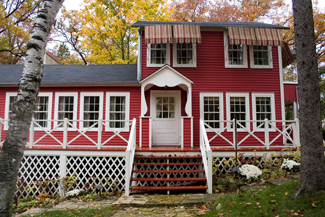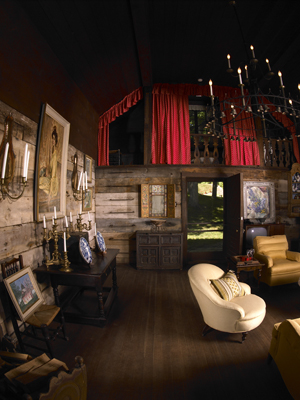 |
|

| Theatrical Oasis |
| Art-chitecture |
| Enchanted Estate |
| Madison Arts Incubator |
| Hand-crafted Healing |
| Designing the Big Day |
| Green Piece |
| Tattoo Taboo? |
| Worth the Wait |
| We Want the Funk |
Enchanted Estate: Broadway's Time Capsule in Rural Wisconsin |
|
||||||||||||||||||||||||||||||||
| Jennifer Evans | |||||||||||||||||||||||||||||||||
As the sunny days of summer grew short in a the small southeastern Wisconsin town of Genesee Depot in late August 1983, George Bugbee lowered the window shades in each room of the estate of former Broadway legends Alfred Lunt and Lynn Fontanne. Moving from window to window, Bugbee, Alfred’s brother-in-law, forced the sunlight from the rooms once filled with the voices and laughter of well-known 20th century actors and actresses; rooms where theatrical lines and everyday dialogue merged as one; rooms once filled with a smoky haze from chain-smoking actors and a fireplace that burned year round. When Bugbee finished, he locked the door behind him and retreated up the hill to an old Swedish cottage on the Lunts’ estate, where he would stay until his death some 12 years later.
Alfred Lunt and Lynn Fontanne ruled the American stage from the early-1920s through the 1960s, earning recognition as “the greatest acting team in the history of the English speaking theater.” Before meeting offstage in 1919, Lunt, a native from Milwaukee and Fontanne, born and raised in Essex, England, had each spent years painstakingly climbing the ranks of American theater. Within months of each other, both Lunt and Fontanne began acting in the roles that would ultimately launch them into stardom. After falling in love, marrying and spending years acting in separate plays, Lunt and Fontanne took a significant pay cut in signing with The Theater Guild. However, this was in exchange for two requests: the couple would only perform together (earning the nicknames such as “the Fabulous Lunts” and “the Lustrous Lunts”) and they would spend every summer away from the theater, retreating with family and friends to the home they created in Genesee Depot. What began with Alfred’s original purchase of a small farmhouse on several acres of land for his mother and sisters in 1914 expanded over the years to encompass an estate of more than 100 acres. The estate grew to include a main house and cottage, studio, barn, chicken coop, creamery, cutting garden and acres of wheat and corn fields. With each estate addition and general maintenance needed, Lunt and Fontanne employed locals from Genesee Depot, offering much-needed work for members of the community during the Great Depression. During the couple’s early years in Wisconsin, Lunt and Fontanne worked to create the perfect summer retreat. Although withdrawing from the theater for only a few months of the year, the Lunts never truly left the stage. Instead, during long summer days, they crafted a home that reflected their passion for theater and their strong attention to detail. Each room of the estate became their very own stage. The Lunts used theatrical lighting techniques to create a desired ambiance; thematic designs repeatedly layered throughout the house, and paintings, stage props, antiques and gifts from friends to create a meticulously crafted scene.
As with their acting, the Lunts sought perfection in the design of Ten Chimneys. Lunts commissioned theater-set designer Claggett Wilson to hand-paint murals rich with symbolism throughout the house, employed locals to cut out and paint pieces of wallpaper to add depth to walls of the house and collected furniture and decorations as they traveled the world. To ensure a look and style most pleasing, Alfred carried a small notebook with him on all the couple’s travels, with the complete dimensions of the estate, so that he could be sure each purchase had its place. With the amount of detail that Fontanne and Lunt poured into their estate, they enthusiastically welcomed well-known actors and actresses, writers, theater critics and more to Ten Chimneys. Many established and up-and-coming-artists of the 20th century made visits, as did the lesser-known members of the Genesee Depot community. Celebrities such as Katherine Hepburn, Carol Channing, Lawrence Olivier and Nöel Coward could be seen playfully splashing in the pool or gathering around the Lunts' dining room table in formal evening wear. When imagining the Lunts’ dinner guests, enthusiasm radiated from Martin Dable, former paperboy of the Lunts and volunteer docent at Ten Chimneys. “Remember, these were theater people, so dinner probably started at 8 or 10 and it probably went on to 3 or 4 in the morning,” Dable said. “So, that dining room is a very special place. It’s a really busy place, but if you think about what kind of conversations probably took place [there], it’s just sensational and amazing. Think about what changes possibly came about because of the conversations in that dining room.” Although Dable fondly remembers the generous tips and delectable desserts offered to him when he went to collect paper money from the Lunts, he admits that, as a child, he always considered the Lunts just another part of the Genesee Depot community. “From being the toasts of Broadway, Alfred was a farmer out here and he’s working in the fields and he’s getting his hands dirty and he’s milking cows…and he’s wearing overalls,” explained Laurette Greenhalgh, a volunteer docent at Ten Chimneys. “Lynn is sewing with her friends and she’s relaxing with tea in the garden. They kept busy, but it was all activities that gave them relaxation…things that they loved.” After each summer of relaxation and time spent with family and friends, the Lunts would return to the stage rejuvenated and ready to work. On stage, the Lunts shattered the historical mold that suggested actors were to deliver to an audience by shouting lines in their direction in stiff, posed positions. Lunt and Fontanne believed acting should appear more natural and sought realism in the delivery of their lines. Together, they became the first pair to master overlapping dialogue, express physicality on the stage and turn their backs to the audience during a performance. “I think they were always rehearsing,” Dable said. “People like Alfred and Lynn made theater easy for us to watch and listen to.” Twentieth century audiences applauded the revolutionary acting style of the Lunts. They offered a conservative American audience their very first look at a physical stage fight, theatrical infidelity and ménage à trois. The more critics gasped in response to the Lunts, the louder audiences roared. And after each show they starred in had its run on Broadway, the Lunts took their performances on the road. The pair recognized theater did not only belong on the stage in New York or other major cities, but also in the barns and church basements of small towns across the country. “The Lunts believed in bringing theater to the masses… and taking their plays out into the hinterland, out into places like Omaha, Nebraska and Milwaukee, Wisconsin,” said Dan Cummings, a retired theater manager and Ten Chimneys docent. |
|||||||||||||||||||||||||||||||||
About Us | Contact Us | Business Partners | Archives | Sitemap
Copyright 2007 Curb Magazine









